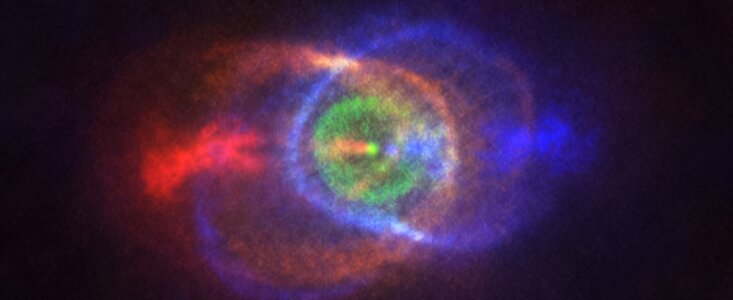Swedish Involvement with the European Southern Observatory

The complex gas environment surrounding the binary HD101584. (Credit: ALMA (ESO/NAOJ/NRAO), Olofsson et al. Acknowledgement: Robert Cumming)
Sweden is one of the five founding members of ESO and took part in signing the ESO convention on 5 October 1962. It officially became a Member State on 17 January 1964. As a founder, the Swedish community of scientists and engineers have contributed to ESO projects in many ways, from participating in scientific discoveries and by contributing to the development of instruments and telescopes.
Sweden currently contributes 2.78% of ESO’s revenue (2021 contribution), worth 5 339 000 EUR.
As of mid 2022, there are two Swedish nationals employed at ESO, both stationed in Germany. Furthermore, ESO has awarded two studentships and five fellowships to Swedish nationals since 2004, as well as one internship since 2014.
Sweden is represented in the various ESO governing and advisory bodies by astronomers and policy experts; the current Swedish representatives of ESO’s various committees with national representation can be found here.
The ESO Science Outreach Network (ESON) includes Swedish representatives who act as ESO’s media and outreach local contacts.
Here follows some information about Sweden's involvement with ESO.
Discoveries by Sweden-based astronomers using ESO telescopes
Swedish researchers and those based at Swedish institutions have been involved in important discoveries using ESO facilities. These include
- Markus Janson (Stockholm University) who, with collaborators, used the SPHERE instrument on ESO’s Very Large Telescope (VLT) to successfully capture an image of a planet orbiting the star b Centauri. At the time of discovery this was the hottest and most massive planet-hosting star system found, with the planet orbiting at 100 times the distance that Jupiter orbits the Sun.
- Hans Olofsson (Chalmers University of Technology) who led a team that caught the beautiful spectacle of two colliding stars in the HD101584 binary, using ALMA.
- Erik Zackrisson (Uppsala University) who was part of the team that used ALMA to detect glowing oxygen in a distant galaxy seen just 700 million years after the Big Bang. This was the most distant galaxy in which oxygen had ever been unambiguously detected.
- The discovery of an extremely powerful magnetic field close to the event horizon of a supermassive black hole by astronomers from Chalmers University of Technology and Onsala Space Observatory in Sweden, led by Ivan Martí-Vidal. This observation, using ALMA, helps astronomers understand the structure and formation of these massive inhabitants of the centres of galaxies.
Swedish involvement in ESO instruments and telescopes at ESO sites
Sweden has contributed to many aspects of ESO, including the technology behind instruments, ESO telescopes and telescopes based at ESO sites. These include
- The CRIRES+ instrument at the VLT, which is a collaboration between ESO, Germany, Sweden and Italy, with the Department for Physics and Astronomy, University of Uppsala as the Swedish partner in the consortium. The goal of CRIRES+ is to search for super-Earths and take a closer look at their atmospheric composition.
- The 4MOST spectrograph which will sit at ESO’s VISTA telescope based at the Paranal Observatory. It is currently being developed by a consortium, which includes Sweden through Lund and Uppsala University. 4MOST will be able to capture the spectra of 2400 objects simultaneously, over an area in the sky equivalent to 20 full Moons.
- APEX, the Atacama Pathfinder Experiment, a collaborative effort between the Onsala Space Observatory and the Max-Planck-Institute for Radio Astronomy (MPIfR) in Bonn, Germany, and supported by ESO.
- SEPIA, the “Swedish ESO PI receiver for APEX”, which has the goal to search for water and other molecules in the Universe. It was designed and built by the Onsala Space Observatory's Group for Advanced Receiver Development (GARD) at Chalmers University of Technology in Sweden and supported by ESO.
The Swedish–ESO Submillimetre Telescope (SEST, decommissioned) was built on behalf of the Swedish Natural Science Research Council (NFR) and ESO at ESO’s La Silla Observatory. It was the only large sub-millimetre telescope in the southern hemisphere at the time of first light. SEST was decommissioned in 2003 and superseded by APEX and ALMA on Chajnantor.
Swedish involvement in ELT instruments
Sweden institutions play a role in developing two instruments on ESO’s upcoming Extremely Large Telescope (ELT)
- The MOSAIC instrument, which will peer closer at distant galaxies at the very edge of the observable Universe. MOSAIC is being developed by a consortium in which Stockholm University participates.
- ANDES, the instrument that will study astronomical objects with unprecedented sensitivity, will also be a first-generation ELT instrument. Uppsala University participates in the consortium that develops ANDES.
Swedish industry and technology contributions to ESO
Swedish companies and higher-education institutions have contributed significantly to the ALMA and APEX projects. For example, the Chalmers Technical University was responsible for some of the components of the ALMA Band 5 detectors and for the production of the ALMA Band 2 cold cartridge assemblies. Omnissys Instruments AB designed and produced water vapour radiometers for ALMA, with Onsala Space Observatory and Chalmers also contributing to the development of these devices.
Swedish industry contributions to the ELT
The main ELT related contracts already awarded to Swedish companies include
- The non-trivial task of cleaning the M1 mirror segments of the ELT. This will be possible thanks to specialised washing and stripping plants produced by the Swedish company Fagerström Industrikonsult AB.
- The company Cosylab Sweden AB, which provided core integration infrastructure for the ELT’s control system